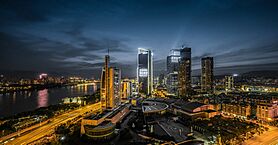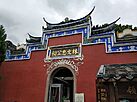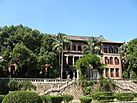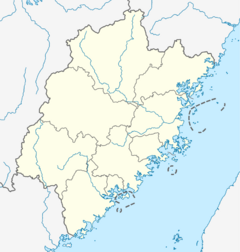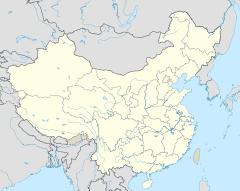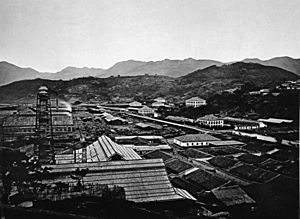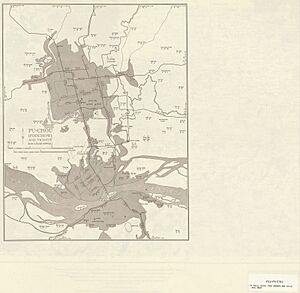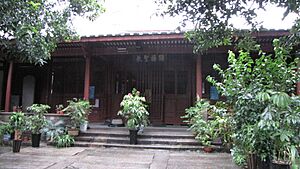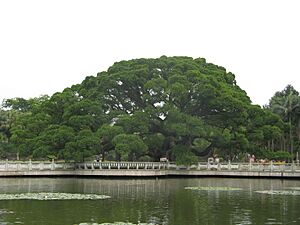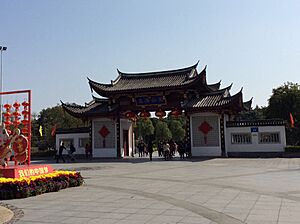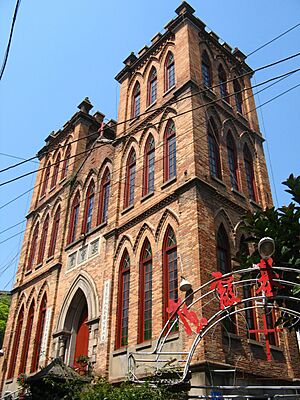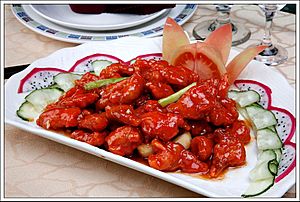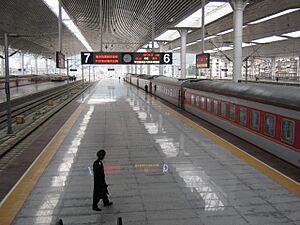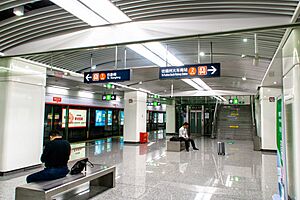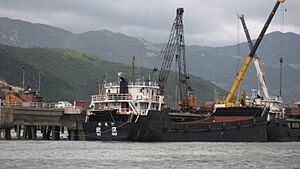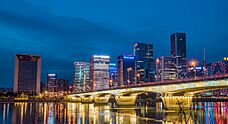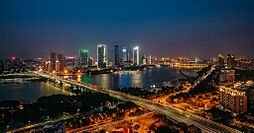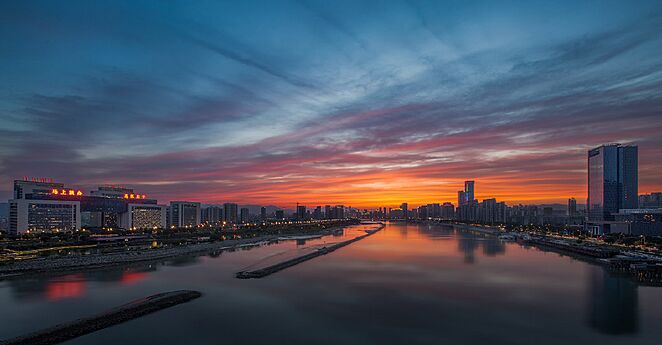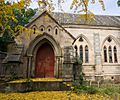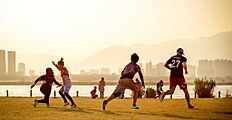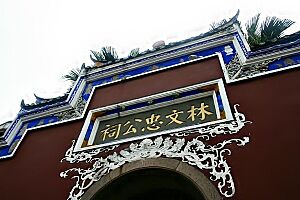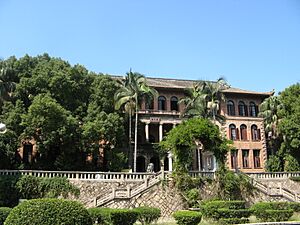Fuzhou facts for kids
Quick facts for kids
Fuzhou
福州市
Hokchew
|
|
|---|---|
|
Prefecture-level city
|
|
|
Fuzhou CBD
Luoxing Tower
Three Mountains and One River Sculpture
Zhenhai Tower
Temple of Lin Zexu
Hwa Nan College
Sanfang Qixiang
|
|
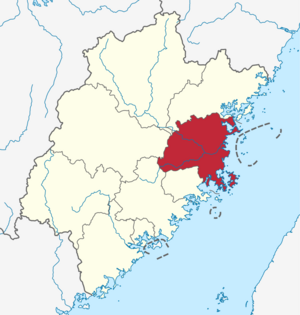
Location of Fuzhou City jurisdiction in Fujian
|
|
| Country | China |
| Province | Fujian |
| Municipal seat | Gulou District |
| Divisions - County-level |
6 districts, 6 counties, & 1 County-level cities(2017) |
| Government | |
| • Type | Prefecture-level city |
| • Body | Fuzhou Municipal People's Congress |
| Area | |
| • Prefecture-level city | 12,231.9 km2 (4,722.8 sq mi) |
| • Water | 4,634 km2 (1,789 sq mi) |
| • Urban
(2018)
|
1,768.2 km2 (682.7 sq mi) |
| Population
(2020 census)
|
|
| • Prefecture-level city | 8,291,268 |
| • Density | 677.8397/km2 (1,755.597/sq mi) |
| • Urban | 4,094,491 |
| • Urban density | 2,315.63/km2 (5,997.45/sq mi) |
| • Rural | 4,196,777 |
| GDP | |
| • Prefecture-level city | CN¥ 1.132 trillion US$ 161.5 billion |
| • Per capita | CN¥ 135,298 US$ 19,293 |
| Time zone | UTC+8 (CST) |
| Postal code |
350000
|
| Area code(s) | 591 |
| ISO 3166 code | CN-FJ-01 |
| License plate prefixes | 闽A |
| Local dialect | Fuzhou language of the Eastern Min Language |
| Website | Fuzhou.gov.cn |
| Fuzhou | |||||||||||||||||||||||||||||||||||
|---|---|---|---|---|---|---|---|---|---|---|---|---|---|---|---|---|---|---|---|---|---|---|---|---|---|---|---|---|---|---|---|---|---|---|---|

"Fuzhou" in Chinese characters
|
|||||||||||||||||||||||||||||||||||
| Chinese | 福州 | ||||||||||||||||||||||||||||||||||
| Postal | Foochow | ||||||||||||||||||||||||||||||||||
| Literal meaning | "Blessed Prefecture" | ||||||||||||||||||||||||||||||||||
|
|||||||||||||||||||||||||||||||||||
Fuzhou is the capital city of Fujian Province in China. It sits between the Min River to the south and the city of Ningde to the north. These two cities together form the Mindong region, known for its unique language and culture.
In 2020, Fuzhou had a population of over 8.2 million people. Like many Chinese cities, its administrative area includes both city and countryside areas. Fuzhou is a fast-growing city and an important center for scientific research. It is also home to several major universities, including Fuzhou University.
Contents
- Understanding Fuzhou's Names
- A Journey Through Fuzhou's History
- Early Beginnings: Before 221 BC
- Ancient Dynasties: Qin and Han (221 BC – 206 AD)
- From Three Kingdoms to Sui Dynasty (200–618 AD)
- Tang to Ten Kingdoms Era (618–960 AD)
- Song Dynasty (960–1279 AD)
- Ming Dynasty (1368–1644 AD)
- Qing Dynasty (1644–1912 AD)
- Republic of China Era
- People's Republic of China Era
- Fuzhou's Geography and Climate
- Fuzhou's Administrative Areas
- Fuzhou's Rich Culture
- Media and News
- Getting Around Fuzhou
- Fuzhou's Economy
- Fuzhou's Cityscape
- Places to Visit in Fuzhou
- Famous People from Fuzhou
- Education in Fuzhou
- See also
Understanding Fuzhou's Names
The name Fuzhou comes from Mount Futo, a mountain northwest of the city. The word -zhou means "settlement" or "prefecture." This is a common way many Chinese cities get their names.
During ancient times, the Fuzhou area was sometimes called Ye. The city's name changed many times between the 3rd and 9th centuries. It finally became "Fuzhou" in 948 AD.
In Chinese, people sometimes call Fuzhou Rongcheng, which means "The Banyan City." This is because of the many banyan trees found there. Older English writings used names like Foochow or Hokchew for the city.
A Journey Through Fuzhou's History
Fuzhou has a very long and interesting history, going back thousands of years.
Early Beginnings: Before 221 BC
Scientists have found signs of two ancient cultures in the Fuzhou area. These are the Huqiutou Culture from around 5000 BC and the Tanshishan Culture from around 3000 BC.
During the Warring States period (around 475–221 BC), people in China called the Fujian area Min Yue. This name suggests that the local people were part of the Yue peoples. These were different tribes who lived across southern China.
Later, the Yue Kingdom fell, and some of its royal family members moved to Fujian. They mixed with the local Yue people, creating the Minyue culture.
Ancient Dynasties: Qin and Han (221 BC – 206 AD)
The first emperor of China, Qin Shi Huang, wanted to control all of southern China. He organized the Fujian area as Minzhong Commandery. However, the area remained mostly independent for about 100 years.
When the Han dynasty began, the Minyue area became an independent kingdom. In 202 BC, a leader named Wuzhu became the King of Minyue. A walled city called Ye was built. This year, 202 BC, is often seen as the founding date of Fuzhou.
In 110 BC, the Han army defeated Minyue. Many Minyue people were moved to other parts of China. This caused the population of Ye to drop. The area later became a county in 85 BC.
From Three Kingdoms to Sui Dynasty (200–618 AD)
During the Three Kingdoms period, Fuzhou was part of the Eastern Wu kingdom. It had a shipyard for building ships. In 282 AD, during the Jin dynasty, two artificial lakes and a canal system were built in Ye. Modern Fuzhou grew around these water systems.
Around 308 AD, many Chinese people started moving south to Fujian. This happened during times of war or natural disasters in central China.
Tang to Ten Kingdoms Era (618–960 AD)
In 725 AD, the city was officially named "Fuzhou." During the Tang dynasty, Fuzhou's economy and culture grew. More people moved from the north during times of trouble.
In 893 AD, the Wang brothers took control of Fuzhou. They later started their own independent kingdom called the Min Kingdom in 909 AD. They encouraged even more people to move to the area. This kingdom lasted until 945 AD. In 978 AD, Fuzhou became part of the new Song dynasty.
Buddhism became very popular in Fuzhou during the Tang dynasty, and many Buddhist temples were built.
Song Dynasty (960–1279 AD)
Fuzhou became a very important center for learning and culture during the Song dynasty. Many scholars from Fuzhou achieved high ranks in imperial exams.
The Hualin Temple, built in 964 AD, is one of the oldest wooden buildings still standing in China. New city walls were built many times. Fuzhou had more layers of walls than even the Chinese capital!
During the Southern Song dynasty, Fuzhou became even richer. Famous scholars like Zhu Xi and Xin Qiji came to live and work there.
Ming Dynasty (1368–1644 AD)
Between 1405 and 1433, a large fleet led by Admiral Zheng He sailed from Fuzhou to the Indian Ocean seven times. They even reached the east coast of Africa.
The Ming government gave Fuzhou special rights for trade with the Philippines.
Qing Dynasty (1644–1912 AD)
In 1839, Lin Zexu, a Fuzhou native, tried to stop the opium trade in China. His actions led to the First Opium War with Great Britain. After the war, the Treaty of Nanjing (1842) made Fuzhou one of five Chinese treaty ports. This meant it was open to Western merchants and missionaries.
Fuzhou became an important place for Protestant missionaries. They built hospitals and schools, like the Woolston Memorial Hospital.
On August 23, 1884, a battle happened between the French fleet and the Chinese Fujian Fleet. The Chinese fleet was completely destroyed in Mawei Harbor.
Republic of China Era
On November 8, 1911, a revolution started in Fuzhou. The Qing army surrendered after a night of fighting.
Japanese Occupation
During the Second Sino-Japanese War (1937-1945), Japanese forces attacked Fujian Province. Fuzhou was occupied by Japanese forces in 1938. The city returned to Chinese control in 1941. However, it was re-taken by Japanese troops in October 1944. Fuzhou remained under Japanese control until May 18, 1945.
After the war, Fuzhou's administrative level was raised from a county to a city.
People's Republic of China Era
The People's Liberation Army took control of Fuzhou on August 17, 1949. In the 1950s, the city was on the front line of the conflict with Taiwan.
Fuzhou developed quickly after China's "reform and opening" policy began in the late 1970s. In 1984, Fuzhou became one of China's first "Open Coastal Cities." This meant it was open to foreign investments.
In the 1990s, Xi Jinping served as the city's leader. He planned for Fuzhou to become a major center for politics, economy, culture, education, transportation, and technology in Fujian Province. He imagined Fuzhou as an important international city.
Fuzhou's Geography and Climate
Fuzhou is located on the northeast coast of Fujian province. It connects with Ningde and Nanping to the north, Quanzhou and Putian to the south, and Sanming to the west.
Fuzhou's Climate
Fuzhou has a humid subtropical climate. This means it has long, very hot, and humid summers. The winters are short, mild, and dry. Heavy rain often falls in the second half of May. Fuzhou can also experience typhoons in late summer and early autumn.
The average temperature in January is about 11.4°C (52.5°F). In July, it's about 29.4°C (84.9°F). The city gets about 1,607 hours of sunshine each year. Snow is very rare in Fuzhou.
| Climate data for Fuzhou (1991–2020 normals, extremes 1951–present) | |||||||||||||
|---|---|---|---|---|---|---|---|---|---|---|---|---|---|
| Month | Jan | Feb | Mar | Apr | May | Jun | Jul | Aug | Sep | Oct | Nov | Dec | Year |
| Record high °C (°F) | 23.6 (74.5) |
28.5 (83.3) |
30.3 (86.5) |
36.2 (97.2) |
37.5 (99.5) |
39.1 (102.4) |
41.7 (107.1) |
40.6 (105.1) |
39.3 (102.7) |
36.7 (98.1) |
33.4 (92.1) |
26.5 (79.7) |
41.7 (107.1) |
| Mean daily maximum °C (°F) | 15.5 (59.9) |
16.6 (61.9) |
19.3 (66.7) |
24.1 (75.4) |
27.8 (82.0) |
31.2 (88.2) |
34.6 (94.3) |
33.8 (92.8) |
31.1 (88.0) |
26.9 (80.4) |
22.6 (72.7) |
17.8 (64.0) |
25.1 (77.2) |
| Daily mean °C (°F) | 11.4 (52.5) |
12.0 (53.6) |
14.4 (57.9) |
19.0 (66.2) |
23.1 (73.6) |
26.6 (79.9) |
29.4 (84.9) |
28.9 (84.0) |
26.7 (80.1) |
22.7 (72.9) |
18.6 (65.5) |
13.7 (56.7) |
20.5 (69.0) |
| Mean daily minimum °C (°F) | 8.8 (47.8) |
9.3 (48.7) |
11.3 (52.3) |
15.7 (60.3) |
20.0 (68.0) |
23.7 (74.7) |
26.0 (78.8) |
25.7 (78.3) |
23.8 (74.8) |
19.7 (67.5) |
15.8 (60.4) |
10.9 (51.6) |
17.6 (63.6) |
| Record low °C (°F) | −1.9 (28.6) |
−0.8 (30.6) |
0.3 (32.5) |
6.2 (43.2) |
10.9 (51.6) |
18.9 (66.0) |
20.7 (69.3) |
20.3 (68.5) |
18.3 (64.9) |
12.2 (54.0) |
4.6 (40.3) |
−1.7 (28.9) |
−1.9 (28.6) |
| Average precipitation mm (inches) | 56.3 (2.22) |
78.6 (3.09) |
129.9 (5.11) |
139.8 (5.50) |
189.3 (7.45) |
228.7 (9.00) |
150.1 (5.91) |
193.4 (7.61) |
133.0 (5.24) |
48.7 (1.92) |
51.0 (2.01) |
43.3 (1.70) |
1,442.1 (56.76) |
| Average precipitation days (≥ 0.1 mm) | 10.0 | 13.1 | 16.3 | 15.3 | 16.9 | 15.9 | 10.3 | 13.4 | 10.4 | 6.2 | 7.7 | 8.8 | 144.3 |
| Average snowy days | 0 | 0.2 | 0.1 | 0 | 0 | 0 | 0 | 0 | 0 | 0 | 0 | 0.1 | 0.4 |
| Average relative humidity (%) | 73 | 75 | 76 | 75 | 77 | 80 | 73 | 75 | 72 | 67 | 70 | 70 | 74 |
| Mean monthly sunshine hours | 91.4 | 82.3 | 96.7 | 112.8 | 119.5 | 132 | 215.6 | 182.4 | 145.1 | 142.2 | 105.3 | 101.8 | 1,527.1 |
| Percent possible sunshine | 27 | 26 | 26 | 29 | 29 | 32 | 51 | 45 | 40 | 40 | 33 | 31 | 34 |
| Source: China Meteorological Administration | |||||||||||||
Fuzhou's Administrative Areas
| Historical population | ||
|---|---|---|
| Year | Pop. | ±% |
| 2000 | 6,386,013 | — |
| 2010 | 7,115,370 | +11.4% |
| 2020 | 8,291,268 | +16.5% |
| Population size may be affected by changes on administrative divisions. | ||
Fuzhou is divided into 6 districts, 1 county-level city, and 6 counties. Even with some changes over time, people still often refer to it as "5 districts and 8 counties." The total area of Fuzhou covers about 9.65% of Fujian Province.
| Map | ||||||
|---|---|---|---|---|---|---|
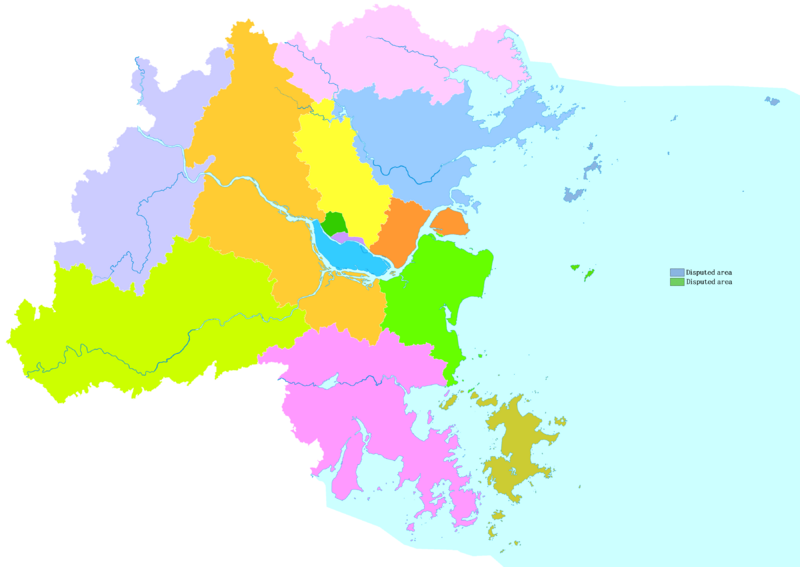
Gulou
Taijiang
Cangshan
Mawei
Jin'an
Changle
Minhou
County Lianjiang
County Luoyuan
County Minqing
County Yongtai
County Pingtan
County Fuqing
(city) The PRC claims (but has never controlled)
most of Lienchiang County, ROC (the Matsu Islands) as a township of its Lianjiang County with the Juguang (Baiquan) Islands claimed as part of Changle District. |
||||||
| Name | Chinese (S) | Hanyu Pinyin | Foochow Romanized | Population (2020 census) |
Area (km2) | Density (/km2) |
| City proper | 4,094,491 | 1,015.07 | 4033.70 | |||
| Gulou District | 鼓楼区 | Gǔlóu Qū | Gū-làu-kṳ̆ | 669,090 | 36.60 | 18,281 |
| Taijiang District | 台江区 | Táijiāng Qū | Dài-gĕ̤ng-kṳ̆ | 411,819 | 18.28 | 22,528 |
| Cangshan District | 仓山区 | Cāngshān Qū | Chŏng-săng-kṳ̆ | 1,142,991 | 139.41 | 8,199 |
| Mawei District | 马尾区 | Mǎwěi Qū | Mā-muōi-kṳ̆ | 290,554 | 254.33 | 1142 |
| Jin'an District | 晋安区 | Jìn'ān Qū | Céng-ăng-kṳ̆ | 789,775 | 566.45 | 1,394 |
| Changle District | 长乐区 | Chánglè Qū | Diòng-lŏ̤h-kṳ̆ | 790,262 | 717.54 | 1101 |
| Suburban and Rural | ||||||
| Minhou County | 闽侯县 | Mǐnhòu Xiàn | Mìng-âu-gâing | 988,200 | 2,133.03 | 463 |
| Lianjiang County | 连江县 | Liánjiāng Xiàn | Lièng-gŏng-gâing | 639,498 | 1,190.67 | 537 |
| Luoyuan County | 罗源县 | Luóyuán Xiàn | Lò̤-nguòng-gâing | 255,214 | 1,081.17 | 236 |
| Minqing County | 闽清县 | Mǐnqīng Xiàn | Mìng-chiăng-gâing | 256,181 | 1,468.90 | 174 |
| Yongtai County | 永泰县 | Yǒngtái Xiàn | Īng-tái-gâing | 281,216 | 2,243.41 | 125 |
| Pingtan County | 平潭县 | Píngtán Xiàn | Bìng-tàng-gâing | 385,981 | 371.09 | 1040 |
| Satellite cities | ||||||
| Fuqing | 福清市 | Fúqīng Shì | Hók-chiăng-chê | 1,390,487 | 1,932.43 | 720 |
| Total | 8,291,268 | 12,153.31 | 682.22 | |||
Fuzhou's Rich Culture
The culture of Fuzhou is special and different from other parts of China. It also has unique features compared to other coastal areas.
Language and Art Forms
Most people in Fuzhou speak Mandarin Chinese. However, many local residents also speak Fuzhounese. This is a special dialect of the Eastern Min language.
Min opera, also called Fuzhou drama, is a popular type of opera in Fujian Province. It's well-known in the Fuzhou area and nearby places where the Fuzhou language is spoken. Min opera became a fixed art form in the early 1900s. There are over 1,000 Min opera plays, often based on folk tales or historical stories.
Religious Beliefs
The main traditional religions in Fuzhou are Mahayana Buddhism and Taoism. Many people practice both at the same time. The city has many Buddhist monasteries and Taoist temples.
Fuzhou also has many local religions. These religions often combine ideas from other beliefs and old legends. For example, the Monkey King, who started as a monkey god, became a God of Wealth in Fuzhou. This happened after the famous novel Journey to the West was written.
The worship of Lady Linshui is very popular in the Min River Valley. It is one of the three most important local religions in Fujian.
Delicious Local Food
Fuzhou cuisine is one of the four traditional cooking styles of Fujian cuisine. It is also one of the eight main Chinese regional cuisines. Fuzhou dishes are light but full of flavor. They focus on the umami taste, which is called xianwei in Chinese. This style aims to keep the natural taste of the ingredients. Fuzhou food often has a mix of sweet and sour flavors.
Soup is a very important part of meals in Fuzhou. It is made in many ways with fresh local vegetables and seafood. Local cooking wine is often added.
Fuzhou is famous for its street food and snacks. Some popular dishes include Fuzhou fish balls, meat-pastry dumplings, and oyster cake. Guong bian is a type of savory pastry. Buddha Jumps over the Wall is a very famous and rich soup. Many of these foods have long histories and local legends. For example, the oyster cake is said to have been invented after a young man had an inspiring dream.
As Fuzhou residents moved overseas, their dishes spread to places like Taiwan, Southeast Asia, and the U.S. You can find Fuzhou fish balls and guong bian in Malaysia, and other dishes in New York's Chinatown.
People in Fuzhou also enjoy special foods during traditional Chinese holidays. For example, red and white rice cakes are eaten during Chinese New Year.
Olive juice, called Ganlanzhi, is a popular drink. It is cloudy and light yellowish-green. Olive trees have grown in Fuzhou since the Tang dynasty. This drink is unique to Fuzhou.
Special Crafts
Fuzhou is known for its "Three Treasures" of traditional arts. These are bodiless lacquerware, paper umbrellas, and horn combs. Bodiless lacquerware, cork pictures, and Shoushan stone sculptures are also called the "Three Superexcellences" of Fuzhou.
Media and News
Fuzhou Evening News, Strait Metropolitan Post, and Southeast Express are the three main newspapers in Fuzhou. Fuzhou Daily is the official newspaper of the local Chinese Communist Party committee. FZTV is the local TV station and has four channels.
Getting Around Fuzhou
Airports
Fuzhou is served by Fuzhou Changle International Airport. This is its main international airport and an important air travel hub in southeast China. The old airport, Fuzhou Yixu Airport, became a military airbase after 1997.
Railways
Fuzhou is a railway center in northern Fujian. The Wenzhou–Fuzhou and Fuzhou–Xiamen Railways are part of a high-speed rail corridor. Trains on these lines can travel up to 250 km/h (155 mph).
The Hefei–Fuzhou High-Speed Railway connects Fuzhou to Beijing. Trains on this line can reach speeds of 350 km/h (217 mph). Other lines, like the Nanping–Fuzhou Railway, connect Fuzhou to inland areas.
Fuzhou has two main railway stations: Fuzhou Station and Fuzhou South Station. Fuzhou Station is often just called Fuzhou Station because it's in the city center.
Metro System
Fuzhou Metro is the first rapid transit system in Fujian province. It has two metro lines currently running and five more lines being built.
Line 1 connects the two railway stations. It opened on May 18, 2016. Line 2 runs east-west across the city. It opened on April 26, 2019.
Seaports
Passenger ships regularly travel between Taiwan's Matsu Islands and the port in Mawei District.
A high-speed ferry also sails across the Taiwan Strait from Pingtan County to Taipei and Taichung. This trip takes about 3 hours.
History of Fuzhou Port
In 1867, the Fuzhou seaport became home to one of China's first big projects using Western technology. This was the Fuzhou Navy Yard. A shipyard and an arsenal were built with French help. A naval school was also opened, which taught European languages and technical sciences. This school trained many officers.
The port was occupied by the Japanese from 1940 to 1945.
Since 1949, Fuzhou has grown a lot. The Min River has been made deeper for ships. In 1956, a railway connecting Fuzhou to the rest of China began operating. The port has also been improved. The main things exported from Fuzhou are timber, fruits, paper, and food.
Fuzhou's Economy
| Year | GDP (billions of CN¥) |
Growth (%) |
|---|---|---|
| 2005 | 172.000 | 9.8 |
| 2006 | 165.694 | 12.2 |
| 2007 | 197.459 | 15.1 |
| 2008 | 228.416 | 13.0 |
| 2009 | 252.428 | 12.8 |
| 2010 | 306.821 | 14.0 |
| 2011 | 373.478 | 13.0 |
Fuzhou is an important center for banking, design, and industries like timber, engineering, papermaking, printing, and textiles. A small iron and steel plant was built in 1958. In 1984, Fuzhou was named one of China's "open" cities. This encouraged foreign companies to invest there.
Handicrafts are still important in the countryside. The city is famous for its beautiful lacquerware and wood products.
Fuzhou is the political, economic, and cultural center of Fujian Province. It is also an industrial center and a seaport. In 2008, Fuzhou's GDP (Gross Domestic Product) grew by 13 percent.
Fuzhou makes products like chemicals, silk and cotton textiles, iron and steel, and processed food. It exports fine lacquerware, handcrafted fans, and umbrellas. The city mainly trades with other Chinese coastal ports. Its exports of timber, food, and paper go through the harbor at Guantou.
Special Economic Zones
Fuzhou has several special zones to help its economy grow:
- Fuzhou Economic & Technological Development Zone: Started in 1985, this zone encourages industries like electronics, telecommunications, and car manufacturing.
- Fuzhou Export Processing Zone: Approved in 2005, this zone helps companies that make products for export.
- Fuzhou Free Trade Zone: Established in 1992, this zone supports industries like electronics, heavy industry, and shipping.
- Fuzhou High-Tech Industrial Development Zone: Set up in 1988, this zone focuses on electronics, information technology, and biotechnology.
- Fuzhou Science and Technology Park: Approved in 1991, this park also focuses on electronics, information technology, and biotechnology.
- Fuzhou Taiwan Merchant Investment Area: Created in 1989, this zone is a business hub for development related to Taiwan. Its main industries are IT, metalwork, food processing, and textiles.
Fuzhou's Cityscape
Places to Visit in Fuzhou
Historical and Cultural Sites
Sanfang Qixiang (Three Lanes and Seven Alleys) is a group of old residential buildings. They date back to the Jin dynasty. Today, it's a walking area with shops. It's the most popular tourist spot in Fuzhou. Many buildings have been restored to attract more visitors.
- Lin Zexu Memorial Hall (Aomen Rd)
- West Lake (An artificial lake built in 282 AD)
- Hualin Temple (Built in 964 AD). Its main hall is the oldest wooden building in southern China.
- Dizang Temple (Founded in 527 AD)
- Xichan Temple (Founded in 867 AD)
- Wu Ta (Black Pagoda) (First built in 799 AD)
- Bai Ta (White Pagoda) (On Mount Yu, first built in 905 AD)
- Yongquan Temple (Founded in 915 AD, on Mount Gu)
- Mount Gu (The tallest mountain in the area, popular for hiking)
- Mount Qi (In Nanyu, Minhou County)
- Luoxing Tower (In Mawei District, built in the Song dynasty)
- Tanshishan cultural relics (Ancient site in Ganzhe, Minhou County)
- Saint Dominic's Cathedral
- St. John's Church, Fuzhou
- Jinshan Temple (First built between 1131–1162 AD)
Parks and Recreation
- Fujian Museum (Near West Lake)
- Wulongjiang Shidi Park (A wetland park)
- Beach Park
- Chating Park
- Zuohai Park
- Minjiang Park (Along the Min River)
- Pingshan Park
- Mount Jinniu Park
- Mount Jinji Park
- Fuzhou National Forest Park
- Sandiejing Forest Park
- Fuzhou Hot Spring Park
- Fuzhou Zoo (Moved to a new location in 2008)
Famous People from Fuzhou
Many notable people have come from Fuzhou, including:
- Sa Zhenbing (1859–1952), a high-ranking naval officer.
- Go Seigen (1914–2014), a famous Go player.
- Lin Huiyin (1904–1955), an architect and writer.
- Lin Juemin (1887–1911), a revolutionary martyr.
- Ingen (1592–1673), a well-known Buddhist monk and poet.
- Marco Polo (1254–1324), an Italian explorer who visited Fuzhou.
- Lin Zexu (1785–1850), a famous official during the Qing dynasty.
- Yan Fu (1854–1921), a scholar who introduced Western ideas to China.
- Lin Sen (1868–1943), who served as President of the Republic of China.
- Bing Xin (1900–1999), a famous writer.
- Watchman Nee (1903–1972), a Christian author.
- Chen Jingrun (1933–1996), a mathematician.
- Chen Kaige (born 1952), a film director.
- Lin Chi-ling (born 1974), a Taiwanese actress and model.
- Jimmy Lin (born 1974), a Taiwanese singer and actor.
- Yao Jinnan (born 1995), an artistic gymnast.
- Ludi Lin (born 1987), a Chinese-Canadian actor.
Education in Fuzhou
Colleges and Universities
Fuzhou is home to several important universities:
- Fujian Normal University (founded in 1907)
- Fuzhou University (founded in 1958)
- Fujian Agriculture and Forestry University (founded in 1958)
These three universities are leaders in the province.
- Fujian Medical University
- Fujian University of Traditional Chinese Medicine
- Minjiang University
- Fujian University of Technology
High Schools
Fuzhou has many high schools, including:
- Fuzhou No.8 Middle School
- Fuzhou Foreign Language School
- Fuzhou Gezhi High School
- Fuzhou No.1 Middle School
- Fuzhou No.3 Middle School
- Fuzhou Senior High School
- Fuzhou No.4 Middle School
- Fuzhou No.2 Middle School
- The Affiliated High School Of Fujian Normal University
- Fuzhou Pingdong Middle School
See also
 In Spanish: Fuzhou para niños
In Spanish: Fuzhou para niños


